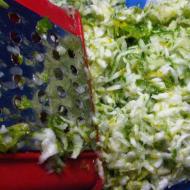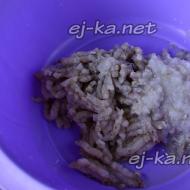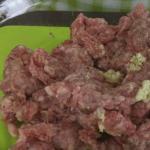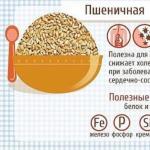
Caviar from salted herring and semolina recipes. Vegetarian “fish” caviar from semolina “Nostalgie”. How to cook caviar from semolina, carrots and herring
We clean the herring from bones and skin.
We pass the fillet itself through a meat grinder, or grind it in a blender. We clean the onion, cut it into several pieces and also turn it into puree using a meat grinder/blender. Mix the onion with herring.

Pour the tomato juice into the pan. Add a little sunflower oil and heat on fire.

When everything boils, add the cereal, but do it carefully, in small portions. Boil the semolina for a couple of minutes, stirring constantly with a spoon. Our goal is not to cook the semolina, but simply to thoroughly soak it in tomato juice and butter.

Pour tomato semolina (cooled) into the herring.
Sp-force-hide ( display: none;).sp-form ( display: block; background: #ffffff; padding: 15px; width: 600px; max-width: 100%; border-radius: 8px; -moz-border -radius: 8px; -webkit-border-radius: 8px; border-color: #dddddd; border-style: solid; border-width: 1px; font-family: Arial, "Helvetica Neue", sans-serif;). sp-form input ( display: inline-block; opacity: 1; visibility: visible;).sp-form .sp-form-fields-wrapper ( margin: 0 auto; width: 570px;).sp-form .sp- form-control ( background: #ffffff; border-color: #cccccc; border-style: solid; border-width: 1px; font-size: 15px; padding-left: 8.75px; padding-right: 8.75px; border- radius: 4px; -moz-border-radius: 4px; -webkit-border-radius: 4px; height: 35px; width: 100%;).sp-form .sp-field label ( color: #444444; font-size : 13px; font-style: normal; font-weight: bold;).sp-form .sp-button ( border-radius: 4px; -moz-border-radius: 4px; -webkit-border-radius: 4px; background -color: #0089bf; color: #ffffff; width: auto; font-weight: bold;).sp-form .sp-button-container ( text-align: left;)

Mix. If necessary, add some salt and some spices.

The herring spread should sit in the refrigerator for a couple of hours, and after that it is completely ready to finally enjoy.

Here's a story from Keren Pevsner:
“We lived in Baku in a house next to the old Intourist, famous for its cuisine. In those distant times, when my grandmother was not a grandmother, but a working woman, she often ordered take-out lunches from Intourist. Nowadays this is called “catering.” She She took the boats, went to the Intourist kitchen, and there they served her a three-course meal.The grandmother exchanged a few words with the chef and went home to feed her family.
One day she came into the kitchen and saw the chef preparing something orange.
“They didn’t bring us red caviar again,” he said. - We have our own, black, in bulk, but no red. Here, I'm cooking.
Black caviar has never been in short supply in Baku."
Yesterday, while making, I decided to make this appetizer at the same time. Shall we try?
Compound:
1 cup semolina.
1 glass of tomato juice.
1 glass of vegetable oil.
2 herrings.
1 onion.
A little dill for decoration.
I decided to make everything from half of the above composition. I divided the quantity of ingredients by two, but left the whole onion, because... it wasn't very big.
Half a glass of semolina, half a glass of tomato juice and half a glass of vegetable oil.

Boil tomato juice and oil together.

Pour semolina into the boiling mixture in a thin stream, stirring continuously. Boil a little until the orange mass thickens and easily comes off the sides of the pan.

Switch off. Cool.
Cut the herring and pass through a meat grinder together with the onion.

Mix the ground herring with the cooled semolina mixture.


The most important thing is not to eat immediately, but leave it in the refrigerator for a day! Semolina grains should be soaked in herring and onions, and then this “caviar” can be spread on bread and butter, like mincemeat, and eaten.
Bon appetit.

Summary: very, very! I devoured two of these sandwiches, and I feel like I want more! Am I the one who never eats breakfast?! In which, in the morning, except a cup of coffee with a cigarette, you can force nothing into it?! Worthy.
Sandwiches occupy a worthy place on the holiday table. There are a huge number of recipes for their preparation. Sandwiches with red caviar are considered the most popular. But not everyone can afford such an expensive pleasure. I suggest preparing an imitation of red caviar, an interesting appetizer - caviar made from semolina and herring. Once upon a time, during times of food shortages, this dish was very popular.
This sandwich spread is very quick and easy to prepare using available ingredients. I offer 2 options, let's start cooking?
We clean the herring from skin and bones. We pass the fillet through a meat grinder. Chop the onion as desired and pass through a meat grinder with a fine wire rack.
Pour oil and tomato juice (I use homemade) into a small thick-bottomed saucepan and bring to a boil over heat.
Pour semolina into the boiling mixture in a thin stream, stirring constantly. Stir the mixture until it becomes thick and begins to pull away from the sides of the pan.
Combine the herring mass with the semolina mass, mix thoroughly, let it cool and put it in the refrigerator for 2-3 hours so that the “caviar” from the semolina and herring is infused and imbued with the fishy aroma.
Spread the finished “caviar” from semolina and herring on bread, decorate with herbs and serve.
Surely many of you buy salted herring in a jar or bucket. The herring is eaten, but the brine remains, which is thrown away as unnecessary. I propose to prepare another version of false caviar - “caviar” from semolina in herring brine.
The products you need for cooking are in front of you.
Pre-fry the tomato paste in a small amount of vegetable oil.
Pour vegetable oil and herring brine (pre-strained) into a small saucepan with a thick bottom. Add the fried tomato paste, stir well, put on the fire, and bring to a boil.
Then pour in the semolina in a thin stream, stirring constantly, avoiding the formation of lumps, boil for half a minute, remove from heat.
Add the onion, previously chopped with a blender or meat grinder, mix until smooth.
That's it, semolina caviar in herring brine is ready.
Sandwiches occupy a worthy place on the holiday table. There are a huge number of recipes for their preparation. Sandwiches with red caviar are considered the most popular. But not everyone can afford such an expensive pleasure. I suggest preparing an imitation of red caviar, an interesting appetizer - caviar made from semolina and herring. Once upon a time, during times of food shortages, this dish was very popular.
This sandwich spread is very quick and easy to prepare using available ingredients. I offer 2 options, let's start cooking?
We clean the herring from skin and bones. We pass the fillet through a meat grinder. Chop the onion as desired and pass through a meat grinder with a fine wire rack.

Pour oil and tomato juice (I use homemade) into a small thick-bottomed saucepan and bring to a boil over heat.

Pour semolina into the boiling mixture in a thin stream, stirring constantly. Stir the mixture until it becomes thick and begins to pull away from the sides of the pan.

Combine the herring mass with the semolina mass, mix thoroughly, let it cool and put it in the refrigerator for 2-3 hours so that the “caviar” from the semolina and herring is infused and imbued with the fishy aroma.

Spread the finished “caviar” from semolina and herring on bread, decorate with herbs and serve.

Surely many of you buy salted herring in a jar or bucket. The herring is eaten, but the brine remains, which is thrown away as unnecessary. I propose to prepare another version of false caviar - “caviar” from semolina in herring brine.
The products you need for cooking are in front of you.

Pre-fry the tomato paste in a small amount of vegetable oil.

Pour vegetable oil and herring brine (pre-strained) into a small saucepan with a thick bottom. Add the fried tomato paste, stir well, put on the fire, and bring to a boil.

Then pour in the semolina in a thin stream, stirring constantly, avoiding the formation of lumps, boil for half a minute, remove from heat.

Add the onion, previously chopped with a blender or meat grinder, mix until smooth.

That's it, semolina caviar in herring brine is ready.

Step 1: prepare the lemon.
To prepare the dish we need 1 tablespoon freshly squeezed lemon juice. Therefore, we rinse the citrus under running water and place it on a cutting board. Using a knife, cut it into two halves and then squeeze out each lemon part using a juicer.Step 2: prepare semolina porridge.

Pour purified water into a small saucepan and place the container over medium heat. When the water boils, turn the heat to low and pour the semolina into the pan. You can immediately salt the mixture a little so that grains of semolina do not stick to the walls of the container. From time to time, stirring with a tablespoon, cook the semolina porridge for 7-10 minutes until it begins to thicken and becomes dense in consistency. Immediately after this, turn off the burner, cover the pan with a lid and set aside to cool quietly to room temperature. During this time, the porridge will thicken even more.
Step 3: prepare the herring fillet.

We rinse the herring fillets lightly under running water and place them on a cutting board. With clean hands, remove the protective film and, if necessary, remove large seeds. Using a knife, cut the fish into small pieces and transfer to an empty plate.

Using a meat grinder with a fine grid, grind the pieces of herring directly into the same plate and set aside for now.
Step 4: prepare caviar from semolina.

Place the cooled semolina porridge, ground herring and add ground red pepper into a medium bowl. Using a fork, mix everything thoroughly until we get a homogeneous mass. Immediately after this, pour in the vegetable oil in a thin stream and continue mixing everything with a tablespoon. At the end, add freshly squeezed lemon juice and salt to taste, mix everything well again using available equipment and we can serve the caviar to the table.
Step 5: serve semolina caviar.

Using a tablespoon, transfer the finished semolina caviar into a bowl or salad bowl and serve to the dinner table. Such a snack, despite the composition of the ingredients, turns out to be quite tasty and can easily be spread on bread, making sort of sandwiches. Help yourself!
Enjoy your meal!
Instead of freshly squeezed lemon juice, you can use citric acid. Then everything needs to be done “by eye”, since citric acid gives the caviar more acidity than juice. Therefore, it is better to add the component in small portions and taste the snack.
Semolina caviar can be decorated with fresh herbs and tomato slices.
Ready caviar can be stored in the refrigerator for 4-5 days. To do this, transfer the dish into a clean jar, close it tightly with a nylon lid and store it on the middle shelf.
In order to grind herring fillets, you can use a blender instead of a meat grinder. In this case, use the appliance at medium speed for 1-2 minutes.
















